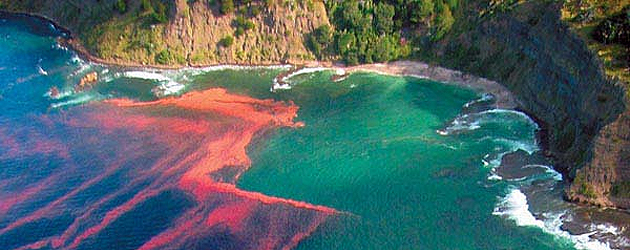Research Uncovers One Possible Cause of Red Tides
An SDSU chemistry professor found that iron may be key factor in the mysterious cause of the deadly algae blooms.

Marine microalgae support world fisheries and help regulate climate, but they can also cause harm with toxic bloom formation. The cause of these blooms remains unknown, but now, a fundamental discovery by San Diego State University scientists finds that iron may be to blame.
The findings are important as algal-associated bacteria may be a factor controlling the formation of toxic algal blooms, commonly known as red tides.
In such blooms, certain algae produce toxins that are concentrated in mollusks and fish, which in turn can kill birds and mammals that feed on them. In addition, toxin-containing shellfish cannot be sold, and beaches that are affected by dangerous algae blooms are forced to close, cutting down on tourism.
Iron may be to blame
“It has long been known that bloom-forming microalgae that influence climate and harm ecosystems and man are closely associated with certain bacterial species, but the reasons why were unknown,” said Carl Carrano, chair of SDSU’s chemistry and biochemistry department and co-publisher of the study.
“We have now found that iron may play a big part in this association, and we hope that our findings will lead to better algae bloom prediction and mitigation strategies.”
Mutually benefical relationship
California Sea Grant scientists at SDSU and the Scottish Association for Marine Science, along with colleagues at the National Oceanographic and Atmospheric Association (NOAA), discovered that the bacteria and algae appeared to have evolved a mutually beneficial arrangement in which the bacteria promote the growth of the algae by releasing a chemical that promotes the uptake of iron, a critical nutrient for algae, while the algae release organic molecules that fuel bacterial growth.
They further found that by aggregating together into dense blooms, these two mutually beneficial effects are accentuated, providing a fundamental reason why the algae grow up to high levels and produce such heavy blooms.
Improving bloom predictions
Researchers hope that these new insights will help scientists and environmental managers develop more realistic bloom formation models, which in turn will enable better timing of bloom predictions and mitigation strategies.
The study was published in Proceedings of the National Academy of Sciences, one of the three most highly cited multidisciplinary science journals in the world.


